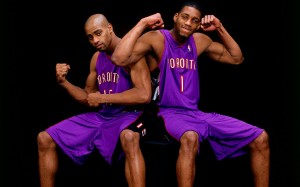The Past, Present, and Future of the Toronto Raptors on its 20th Anniversary
PART 2: MISSING THAT 3RD ELEMENT

I can still recall the date in which Vince Carter put the Toronto Raptors on the NBA Map: February 12, 2000. On this date in NBA history, Carter, known as “Air Canada,” “Half-Man, Half-Amazing,” and “Vinsanity,” put on a show when he electrified the crowd at the 2000 NBA Slam Dunk Contest, an event broadcast live and seen by many in North America and around the world.
Led by Carter, the team was competitive as the franchise made the postseason for three consecutive years between 2000 and 2002 (a feat that has not been matched since). The roster had both talent depth. The 1999-2000 edition featured Carter, shooting guard Doug Christie, three-point specialist Dell Curry, Antonio Davis, Tracy McGrady, Charles Oakley, Alvin Williams, and Kevin Willis. The 2000-2001 team lost Christie and McGrady (who signed with the Sacramento Kings and the Orlando Magic respectively) to unrestricted free agency but had new blood in power forward Keon Clark, small forward Tracy Murray, and shooting guard Morris Peterson. The 2001-2002 Raptors saw the departure of Oakley and Willis but the team was able to replace them with future Hall-of-Fame center Hakeem Olajuwon and Jerome “Junkyard Dog” Williams. By all accounts, these players are all solid performers on the court so how come the Raptors never made it past the second round of the NBA playoffs, let alone win an NBA Championship?
The answer lies in Carter’s supporting cast. While he was arguably the best offensive NBA weapon in the entire league during those three seasons, averaging 25.7, 27.6, and 24.7 points per game in 1999-2000, 2000-2001, and 2001-2002, Carter never had the sidekicks that he needed to take the team to the next level. True championship teams that are considered dynasties have three all-star calibre players (referred to as the Big Three), out of which there may be one or more future Hall-of-Famers. The Toronto Raptors, to put it bluntly, never had a Big Three throughout their history; instead, what the franchise had during its glory dates was a lone ranger in Carter with an above average supporting cast.
Even though the term Big Three is mostly associated with LeBron James, Dwyane Wade, and Chris Bosh as they joined force to win back-to-back NBA Championships in 2012 and again in 2013 as well as reaching the finals in 2011 and again in 2014 within a four-year span, NBA history suggests that the concept is not new. Case in point: Michael Jordan, arguably the greatest NBA player ever, won three consecutive NBA Titles (the first three-peat) with the Chicago Bulls from 1991 to 1993 because he had Scottie Pippen and Horace Grant as his wingmen to execute Phil Jackson’s triangle offense. Jordan then came of out retirement to lead the Bulls to another three consecutive NBA Championships from 1996 to 1998 (a second three-peat) because not only was Pippen able to play the role of Robin to support Jordan as Batman, but rebounding king Dennis Rodman was able to slide into the role that Grant played in the first three-peat by becoming that third element that championship teams need if they were to achieve and maintain dynasty status.
Moving from the 1990s into the 2000s, we continue to see that third element in championship teams that are considered dynasties. The San Antonio Spurs, which won the NBA Title in 1999, 2003, 2005, 2007, and 2014, were predominately anchored by future Hall-of-Famer Tim Duncan. Yet, he had superstar David “The Admiral” Robinson playing alongside him during the championship runs in both 1999 and 2003, not to mention that all-star shooting guard Manu Ginobili and all-star point guard Tony Parker were both on the 2002-2003 roster to serve as that third element (technically, this means that the Spurs had an unprecedented fourth element on their 2003 championship team which no other teams could come close to matching). Even though Robinson eventually retired, Duncan, Ginobili, and Parker continue to dominate as a Big Three, bringing NBA Titles to San Antonio in 2005, 2007, and 2014.
This brings me back to the Toronto Raptors. As dominating and popular as Carter was from 2000 to 2002, he never had the same elite support that Jordan and Duncan received. McGrady would have filled the shoes of Pippen quite well; in fact, he may well be over-qualified for the position as he put together seven consecutive all-star seasons, including leading the NBA in scoring twice (2002-2003 and 2003-2004). Unfortunately, McGrady left the Raptors just before he matured into a bona fide superstar the next season for Orlando because he wanted to lead his own team and not live in the shadow of Carter. Thus, he may not have been a very good second element for Carter even if he had remained in Toronto.
Assuming for the moment that McGrady was willing to stay in Toronto and play the role of Robin, and assuming that he was just as productive and put up the same numbers as he did for the Magic between 2000 and 2007, which is unlikely in reality since Carter would be the first scoring option and McGrady would not have the basketball in his hand nearly as often, the Raptors would still be missing that third element that championship teams possess. The closest thing the team had to the missing third element is Antonio Davis. That said, with only one all-star appearance (during the 2000-2001 season) in his career, I would not put him in the Rodman category (although he would match well with Grant). Certainly, Davis would not be mistaken for Ginobili or Parker.
Is having the third element to round out the Big Three an absolute must to bring an NBA championship to Toronto? The answer is no. To understand the reasons, stay tuned for Part 3 of my article.
